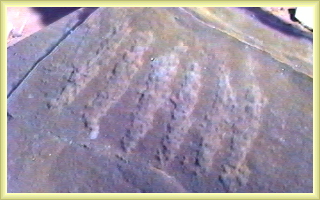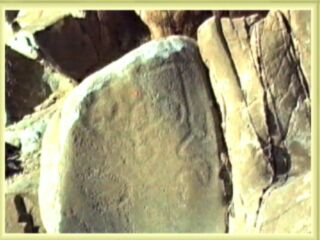


PILGRIMS to INYO
Christians, Celts, Islam and Others
This petroglyph site has work that can be identified as religious icons. The ever present Native American and Celtic theologies are accompanied by others. The symbolism in one case has re-evolved into a modern emblem. The recognized icon is Icthys, the fish, a symbol of the age of Pisces and adopted as a symbol of Christianity. Abandoned in about the year 800 by Roman Christian authority because of the astrological connections, it has been revived in modern times as the symbol of Christians reborn. The patination on the design places it to a time well before the official introduction of Christianity anywhere nearby. The fact that Roman Christian authorities, keepers of all sorts of records, profess to no knowledge of the pre-Columbian introduction of Christianity leads to the suggestion that this may be another sect, perhaps Nestorian. History notes how this sect was significantly less aggressive and accepted into communities where the intolerant and violence prone Roman Christians and Moslems were not welcome. The common root suggests there may be little difference in icons and notational devices used by either sect.
Dr. Alan Gillespie and I have had some discussion as to whether this design was man made or natural. My arguments favor man made for several reasons. First and foremost is the fact that the design crosses a natural fracture, not once but twice; and at nearly right angles. This shows an unnatural disregard for linearity. The surface itself is the product of being pounded by surf and storm strewn rocks for several thousand years, the result was the rounded nub now exposed. The surface is no longer stratified in fracture layers, but arbitrary abrasion. The "fish" crosses many boundaries.
Examination of the design has led to the conclusion that it was created by forcing and dragging a metal blade across the rounded corner. The narrow width in the cut cannot be replicated using stone tools. Under scrutiny, the disturbed patination forming a cross at the head, shows where the maker accidently overlapped his strokes. This is a unique method of application that has been previously overlooked. No other examples of this type manufacture are known to exist.
The other argument states that the design is the result of fracturing along weak strata. Because the marble is made of compressed coral and seabed matter, this is a possability. Whether of natural or man made manufacture, the image remains obvious and clear. The concept of petromantic messages must be applied for understanding the significance of the imagery, especially in the framework of a visiting missionary and his desire to make conversions.
The fish exists on a extension of the boulder that contains the inscription that Dr. Barry Fell called "The Good Shepherd". Dr. Fell recognized this as a Christian symbol but didn't have the knowledge that it was directly adjacent to a sun and shadow device that noted the equinox or accompanied by the Icthys symbol. Once appraised, he suggested that the meaning of the "Good Shepherd" design was connected with the celebration of Easter. The timing of the Christian feast is keyed upon lunar phase following the vernal equinox.
Another connection with the Easter celebration and a solar device to note the equinox is found in Rome. In the south wall of an ancient building in the Vatican called "The Tower of the Winds," is a small hole. This hole projects a stream of sunlight onto the well polished floor. The path of the spot of light on the floor varies according to solar position, of course. On the equinox, the path of light traverses directly through a circle inscribed on a disk, set and cemented as part of the floor. The notation of this event was used to determine the proper timing for the celebration of Easter. The dependence on a carefully calculated but inaccurate calendar allowed errors to accumulate. Michele Berionne of Rome, informs me, after getting special permission to witness the event, that the observatory was constructed in 1580. It must have been very shortly thereafter that the monk in charge noted the calendar error and brought it to the attention of Pope Gregory. The resulting ten day adjustment got us the calendar currently in use world wide. Important is the knowledge and usage of solar position to regulate the calendar.
At INY-272, the Christian motifs share a curious trait. The Good Shepherd Inscription is easily the single most worked and obvious object on the site. The breadth and depth of the pecked lines show that much effort and dedication was used in its construction. Of note is the lack of major patination. This level of patina is similar to the six line design that notes the equinox. Both of these inscribed areas appear to be much later additions to the original work. The "newness" in appearance of this work suggests a great span of time between the creation of the site and the visitations by Christian missionaries.
There is reason to suspect that the six line equinox marker was constructed over an existing design that would date to the sites origins. Directly adjacent is a nub of rock that faces east and has the Ogam letters L-G pecked on it, a simple dedication to Lugh The weathering on these letters indicate great age. The width of the much newer looking six lines may have obliterated older work. It is a noted practice of early Christian missionaries to utilize sites already in existence for local worship and acknowledged as sacred, for purposes of conversion. Thankfully, this mission did not destroy or deface the older pagan artifacts present in the surrounding work.
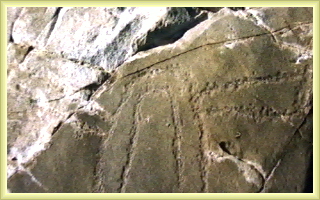
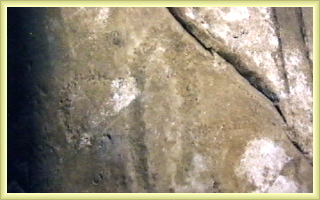
Other religious icons are more difficult to trace. The "Winged Arches" found on the site may be icons related to another religion, the Zoroastrians. Little specific documentation is available, but it is known that this sect put great emphasis on the movement of the heavens. Biblical references suggest that the Three Magi in the story of the birth of Jesus were in fact Zoroastrian Astrologer-Priests attempting to divine a meaning for the rare conjunction that occurred in 7 BC . (On September 8, 7 BC Jupiter and Saturn rose in conjunction in the constellation Pisces, followed immediately by a full moon! ) The records give few clues as to how far spread this religion was, only that it was centered in Persia.
In searching for meaning for the Winged Arches I viewed a program about Iraq's history rich past. There on my TV screen was an ancient temple front, a great arch for a doorway flanked on each side by a huge pair of wings. It was described as a major Zoroastrian temple. The connection here is not all that strong, but I include this information with the suggestion that these beliefs were widespread and part of the North African contingent that used the open trade network. It is probably not coincidence that Egypt's greatest seafaring age was when the empire was under Eastern influence. Wings, the power of flight is explained elsewhere in this presentation.
The indicator of the presence of Islam at INY-272 comes from an inscription I suspected may have been alphabetic and submitted a drawing of it to Barry Fell for comment. Dr. Fell responded that the inscription was the graffiti signature of Zaiid Mohammed and made a few suggestions concerning the style and context. Dr. Fell suggested a date range of 800 to 1200 AD. The amount of patination present on the inscription favors placing the date toward the early end of the range. One has to note that the observatory was already very old at this time. This was an addition by a visitor.
Several other details that may be scripts have been located and recorded. These have a possibility of being Punic, Libyan, dot Ogam (Bricren) and a more common line Ogam. Examples of all these scripts have been found and identified from other American petroglyph sites.

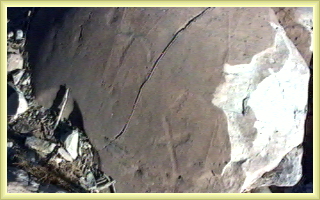
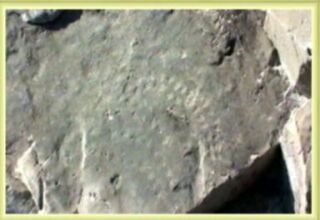

Return to Inyo Connections
Return to Inyo Discoveries
Return to Index
© 2008The Equinox Project, All Rights Reserved. Compiled from the
contents of The Dawson Library
Created for and maintained by The Equinox Project Please email any comments, questions or suggestions to:
info4u@equinox-project.com
NOTE you must remove !!! from the suplied address before using.
Last Modified January 2010
